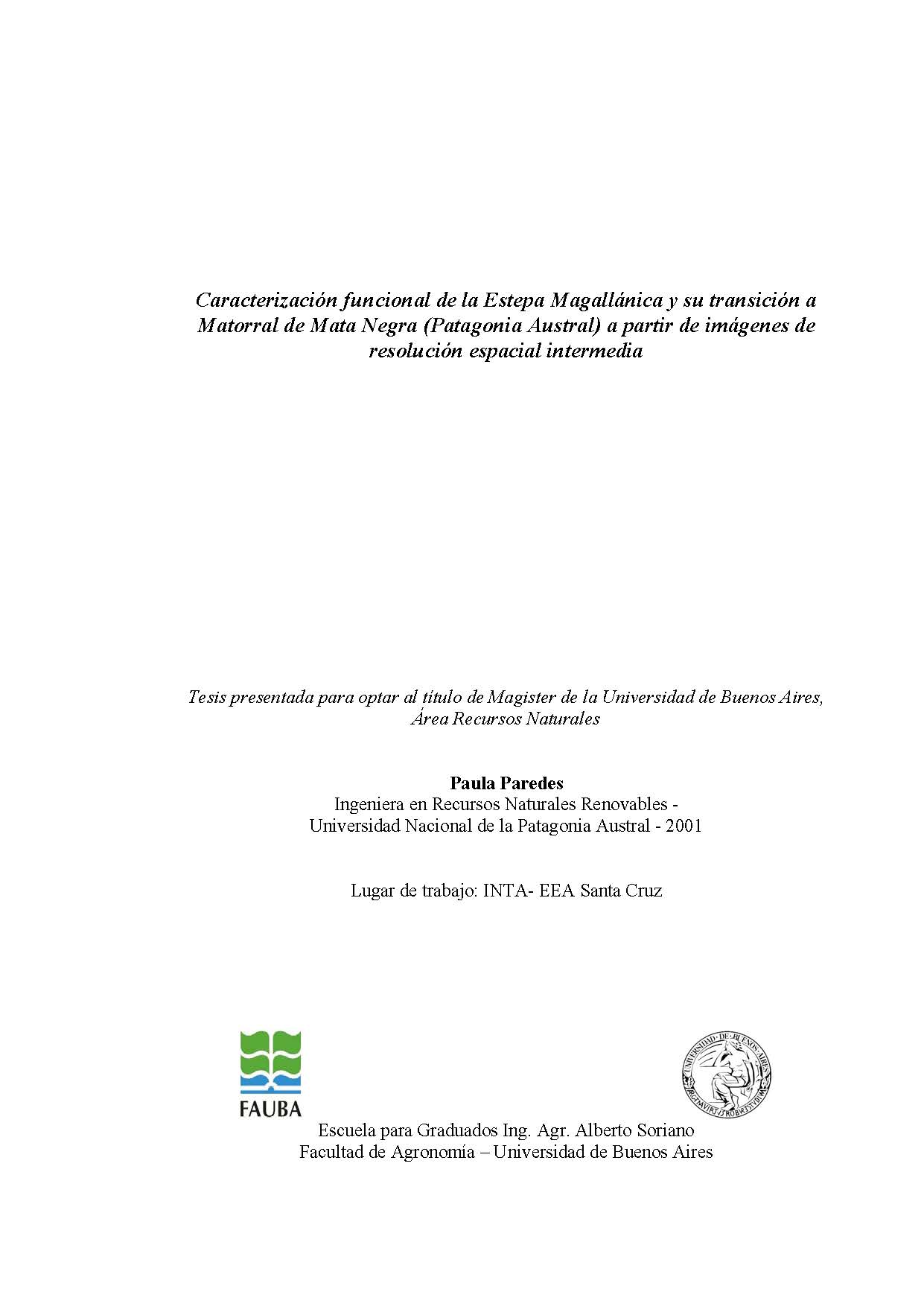Ver ítem
- xmlui.general.dspace_homeCentros Regionales y EEAsCentro Regional Patagonia SurEEA Santa CruzTesisxmlui.ArtifactBrowser.ItemViewer.trail
Caracterización funcional de la estepa magallánica y su transición a matorral de Mata Negra (Patagonia austral) a partir de imágenes de resolución espacial intermedia
Resumen
La PPNA es indicadora de la biomasa disponible y se relaciona con la capacidad de carga de los sistemas pastoriles extensivos. Es posible estimarla a partir de índices de vegetación obtenidos de sensores remotos. El objetivo de esta tesis fue caracterizar funcional y estructuralmente una estepa graminosa (Estepa Magallánica Seca-EMS) y una arbustiva ((Matorral de Mata Negra-MMN) de la Patagonia Austral. En 18 sitios se midió cobertura vegetal (2004 y
[ver mas...]
La PPNA es indicadora de la biomasa disponible y se relaciona con la capacidad de carga de los sistemas pastoriles extensivos. Es posible estimarla a partir de índices de vegetación obtenidos de sensores remotos. El objetivo de esta tesis fue caracterizar funcional y estructuralmente una estepa graminosa (Estepa Magallánica Seca-EMS) y una arbustiva ((Matorral de Mata Negra-MMN) de la Patagonia Austral. En 18 sitios se midió cobertura vegetal (2004 y 2010) y biomasa por estratos (2004 y 2005). Se obtuvieron 8 índices de vegetación a partir de imágenes MODIS (resolución 16 días, 250m, 2003-2010). Se caracterizaron las comunidades vegetales (PCA). Se extrajeron los índices en áreas de 3x3 pixeles y correlacionaron con la biomasa y cobertura medidas a campo. Ambas áreas están dominadas por especies perennes con una cobertura de 66 por ciento En MMN la mitad de este valor corresponde a arbustos. La biomasa aérea total fue de aproximadamente 1000 Kg MS/ha en EMS y el triple en MMN, en ambos casos un 33 por ciento corresponde a material verde. Los índices presentan patrones temporales similares entre áreas, con un máximo a fines de octubre, aunque NDVI y RVI mostraron un segundo pico en abril. El MMN posee mayor biomasa pero los índices fueron 20 por ciento menores que EMS. El NDVI caracterizó mejor la vegetación de la EMS, con correlaciones de 0,69, 0,43 y 0,48 con la fracción verde de biomasa total, intercoironal y coironal, respectivamente. Reflejó además el crecimiento otoñal característico de ambientes con régimen isohigro, limitados por temperatura y humedad. Por el contrario, en el MMN, los índices espectrales y los indicadores de biomasa no correlacionaron. Los valores de regresión obtenidos indican que la evaluación de biomasa disponible a partir de sensores remotos es solo posible en uno de los ecosistemas y muestran que para estimar la receptividad, seria necesaria una calibración local de los índices, dado que la estructura de la vegetación modifica los valores espectrales.
[Cerrar]
The ANNPP is an indicator of the available biomass and is related to the carrying capacity of extensive production systems. It is possible to estimate it using vegetation indexes drawn from remote sensors. The objective of this thesis was to characterize function and structure of two vegetation units of south Patagonia: A grass steppe (Dry Magellan Steppe EMS) and a shrub-steppe (Mata Negra Shrubland MMN). In 18 sites vegetation cover (2004 and 2010) and
[ver mas...]
The ANNPP is an indicator of the available biomass and is related to the carrying capacity of extensive production systems. It is possible to estimate it using vegetation indexes drawn from remote sensors. The objective of this thesis was to characterize function and structure of two vegetation units of south Patagonia: A grass steppe (Dry Magellan Steppe EMS) and a shrub-steppe (Mata Negra Shrubland MMN). In 18 sites vegetation cover (2004 and 2010) and biomass (2004 and 2005) was estimated. Eight
vegetation indexes were calculated using MODIS images (resolution 16 days, 250 m, between 2003-2010). Vegetation communities were analyzed using PCA. Index values were extracted for 3x3 pixel windows and correlated with biomass and cover estimated in the field. Both areas are dominated by perennial species with a similar cover of 66%. In MMN, shrubs represent half of this cover. Aerial biomass was about 1000 Kg MS/ha in EMS, and three times higher in MMN. The proportion of green biomass was 33% in both cases. Indexes presented similar temporal patterns, with a maximum in late
October, although NDVI and RVI showed a second peak in April. Although MMN had greater aerial biomass, index values were about 20% lower than EMS. The NDVI was the index that better described the vegetation of EMS, with correlation coefficients
of 0.69, 0.43 y 0.48 with green fractions of total, short grasses, and tussock biomass respectively. It reflected also the autumn growth that is characteristic of climates with evenly distributed rainfall and limited by temperature and humidity. The regression values indicate that it is possible to evaluate the biomass availability from remote
sensors is only possible in one of the ecosystems and that carrying capacity estimations need local adjustments because the structure of the vegetation modified the spectral values.
[Cerrar]

Autor
Director de Tesis
Descripción
Tesis para obtener el grado de Magister en área Recursos Naturales, de la Universidad de Buenos Aires, en 2011
Fecha
2011
Editorial
Facultad de Agronomía, Universidad de Buenos Aires
Formato
pdf
Tipo de documento
tesis de maestría
Palabras Claves
Derechos de acceso
Abierto
 Excepto donde se diga explicitamente, este item se publica bajo la siguiente descripción: Creative Commons Attribution-NonCommercial-ShareAlike 2.5 Unported (CC BY-NC-SA 2.5)
Excepto donde se diga explicitamente, este item se publica bajo la siguiente descripción: Creative Commons Attribution-NonCommercial-ShareAlike 2.5 Unported (CC BY-NC-SA 2.5)


